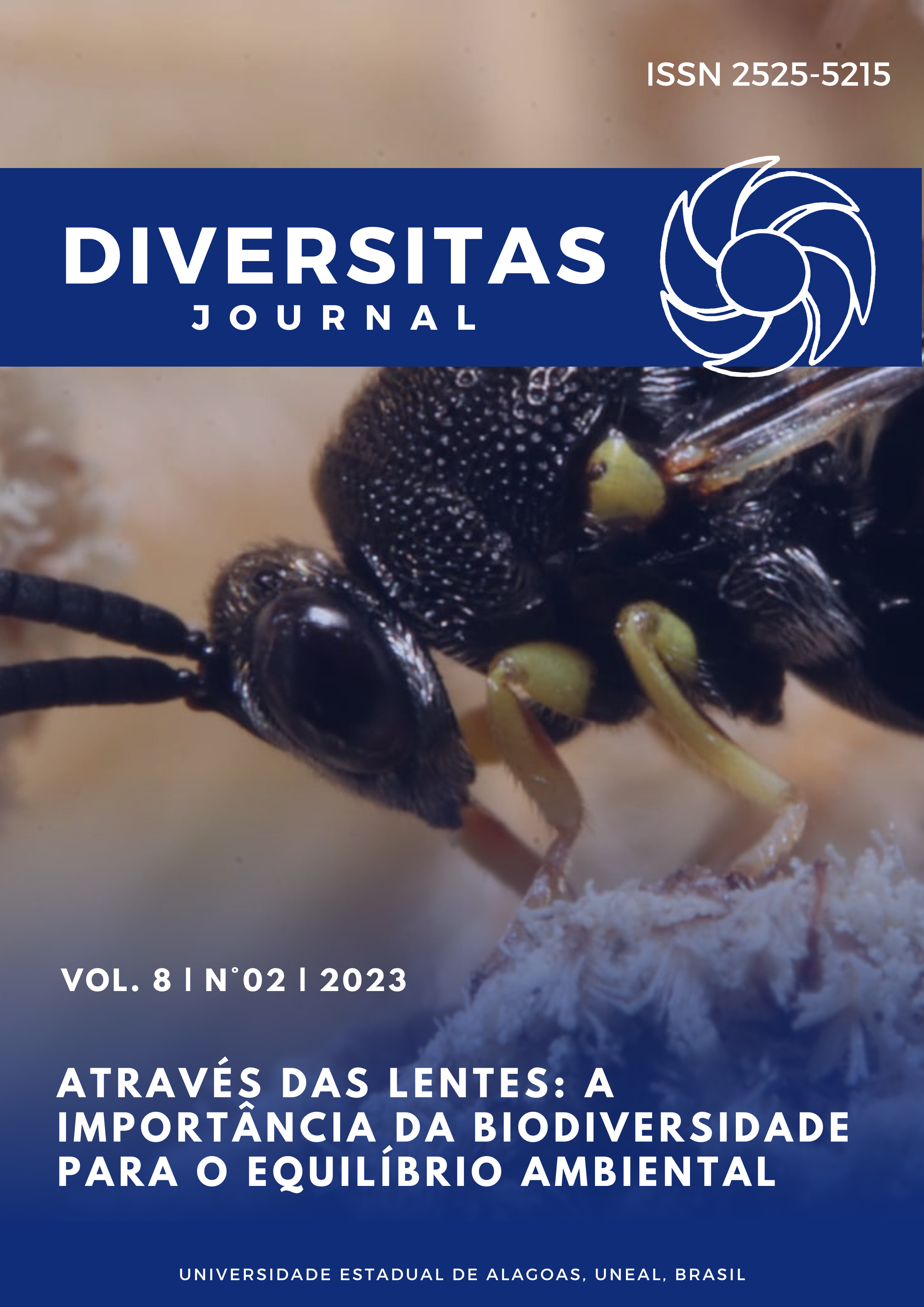Leaf plasticity of species under different light intensities in an urban rainforest
DOI:
https://doi.org/10.48017/dj.v8i2.2465Keywords:
Foliar characteristics, luminosity, functional characteristic, environmental stressAbstract
Leaf characteristics of plants are useful to understand vegetation changes under different environmental pressures because species deal with variations in the levels of luminosity during the process of ecological succession. Assuming that the light availability is a good predictor of the variation of the leaf characteristics, we hypothesized that in environments with a higher light incidence, there will be a greater variation on leaf characteristics (mean and standard deviation) in an urban rainforest fragment. After confirming that geographic distances did not influence the values of the leaf variability indices, Linear Mixed Models (LMMs) were constructed to verify the influence of light intensity on leaf characteristics. All the evaluated leaf characteristics (AF = leaf area, TMSF = leaf dry matter content, AFE = specific leaf area and Cc_mass = chlorophyll content) presented smaller variability in A4<AB. The area with the highest light incidence (A4<AB) showed less variation in the standard deviation, which may indicate that plants in this environment are under the influence of disturbances, which leads to reduced variability. The light was not a good indicator of leaf variability. The AF, AFE, TMSF and Cc_mass, although widely variable in morphological and physiological terms, shown to have less variation in the area with a higher incidence of light and greater disturbances, indicating that more disturbed environments influence on the leaf variability decrease.
Metrics
References
APG IV (2016) The Angiosperm Phylogeny Group. An update of the Angiosperm Phylogeny Group classification for the orders and families of flowering plants: APG IV. Bot. J. Linn. Soc. 181. https://doi.org/10.1111/boj.12385
Bazzaz FA, Carlson RW. Photosynthetic acclimation to variability in the light environment of early and late successional plants. Oecologia. 1982;54(3):313-316.https://doi.org/10.1007/BF00379999
Boukili VK, Chazdon, RL (2017) Environmental filtering, local site factors and landscape context drive changes in functional trait composition during tropical forest succession. Perspectives in Perspect. Plant Ecol. Syst. 24:37–47. https://doi.org/10.1016/j.ppees.2016.11.003
Cornelissen JHC, Quested H, van Logtestijn R (2006). Foliar pH as a new plant trait: can it explain variation in foliar chemistry and carbon cycling processes among subarctic plant species and types? Oecologia 147:315–326. https://doi.org/10.1007/s00442-005-0269-z
Coutinho RQ (1998) Características climáticas, geológicas, geomorfológicas e geotécnicas da Reserva Ecológica de Dois Irmãos. Recife Pernambuco-Brasil pp. 21–50.
Crawley MJ (2007) The R Book. New York: Wiley.
Dorn LA, Pyle EH, Schmitt J. (2000) Plasticity to light cues and resources in Arabidopsis thaliana: testing for adaptive value and costs. Evolution 54:1982-1994. https://doi.org/10.1111/j.0014-3820.2000.tb01242.x
Frazer GW, Canham CD, Lertzman KP (1999). Gap Light Analyzer (GLA), Version 2.0: Imaging software to extract canopy structure and gap light transmission indices from true-colour fisheye photographs, user’s manual and program documentation. New York.
Freitas MA, Costa F, Morais A (2011) Manual de Instalação Parcelas RAPELD: Protocolo de Instalação de Parcelas Terrestres. INPA. Available in: http://ppbio.inpa.gov.br/manuais. Accessed: 19 September 2014.
Gratani L (2014) Plant phenotypic plasticity in response to environmental factors. Adv. Bot. Res. Article ID 208747, 17 p. http://dx.doi.org/10.1155/2014/208747
Ibge (2012) Instituto Brasileiro de Geografia e Estatística. Manuais Técnicos em Geociências: Manual Técnico da Vegetação Brasileira, Rio de Janeiro.
IBM Corp. Released (2011) IBM SPSS Statistics for Windows, Version 20.0. Armonk, NY: IBM Corp.
Kraft N, Ackerly DD (2014) The assembly of plant communities. In: R. Monson (editor). The Plant Sciences - ecology and the environment. Berlin: Springer-Verlag. p. 67-88.
Lasky JR, Sun, IF, Su SH, Chen, ZS, Keitt, TH (2013) Trait-mediated effects of environmental filtering on tree community dynamics. J. Ecol. 101:722–733.doi: 10.1111/1365-2745.12065
Laurans M, Martin O, Nicolini E, Vincent G (2012). Functional traits and their plasticity predict tropical trees regeneration niche even among species with intermediate light requirements. J. Ecology 100:1440–1452. https://doi.org/10.1111/j.1365-2745.2012.02007.x
Lebrija-Trejos E, Meave JA, Poorter L, Perez-Garcia A, Bongers FE (2010) Pathways, mechanisms and predictability of vegetation change during tropical dry forest succession. Perspect. Plant Ecol. 12:267–275. https://doi.org/10.1016/j.ppees.2010.09.002
Legendre P, Fortin MJ (1989) Spatial pattern and ecological analysis. Vegetatio 80:107–138. https://doi.org/10.1007/BF00048036
Letcher SG, Chazdon RL (2009) Rapid recovery of biomass, species richness, and species composition in a forest chronosequence in Northeastern Costa Rica. Biotropica 41:608-617. https://doi.org/10.1111/j.1744-7429.2009.00517.x
Letcher SG, Chazdon RL (2009) Rapid recovery of biomass, species richness, and species composition in a forest chronosequence in northeastern Costa Rica. Biotropica 41:608-617.https://doi.org/10.1111/j.1744-7429.2009.00517.x
Lohbeck M, Poorter L, Lebrija-Trejos E, Martínez-Ramos M, Meave JA, Paz H, Pérez-García EA, Romero-Pérez IE, Tauro A, Bongers F (2013) Successional changes in functional composition contrast for dry and wet tropical forest. Ecol. 94:1211–1216. https://doi.org/10.1890/12-1850.1
Lusk CH, Falster DS, Jara‐Vergara CK, Jimenez‐Castillo M, Saldaña‐Mendoza A (2008) Blackwell Publishing Ltd Ontogenetic variation in light requirements of juvenile rainforest evergreens. Funct. Ecol. 22:454–459. https://doi.org/10.1111/j.1365-2435.2008.01384.x
Magnusson WE, Lima AP, Luizão R, Luizão F, Costa FRC, Castilho CV, Kinupp VF (2005) RAPELD: a modification of the Gentry method for biodiversity surveys in long-term ecological research sites. Biota Neotrop. 2:1–6. http://dx.doi.org/10.1590/S1676-06032005000300002
Malhi Y, Girardin CA, Goldsmith GR, Doughty CE, Salinas N, Metcalfe DB, ... & Aragão LE (2016) The variation of productivity and its allocation along a tropical elevation gradient: a whole carbon budget perspective. New Phytol. 214:1019–1032. http://doi: 10.1111/nph.14189
Mc-cune MJ, Mefford (2011) PC-ORD. Multivariate Analysis of ecological data. Version 6 MJM Software, Gleneden Beach, U.S.A.
Menge DNL, Chazdon RL (2016) Higher survival drives the success of nitrogen-fixing trees through succession in Costa Rican rainforests. New Phytol. 209:965-977. http://doi: 10.1111/nph.13734
Nicotra AB, Atkin OK, Bonser SP, Davidson AM, Finnegan EJ, Mathesius U, Poot P, Purugganan MD, Richards CL, Valladares F, van Kleunen M (2010) Plant phenotypic plasticity in a changing climate. Trends Plant Sci. 15:684–692. https://doi.org/10.1016/j.tplants.2010.09.008
O’neal ME, Landis D, Isaacs R (2002) An inexpensive, accurate method for measuring leaf area and defoliation through digital image analysis. J. Econ. Entomol. 95:1190-1194. https://doi.org/10.1603/0022-0493-95.6.1190
Pérez-Harguindeguy N, Diaz S, Gamier E, Lavorel S, Poorter H, Jaureguiberry P, ... & Urcelay C (2013) New handbook for standardized measurement of plant functional traits worldwide. Aust. J. Bot. 61:167–234. https://doi.org/10.1071/BT12225_CO
Pernambuco (2014) Decreto nº 40.547, de 28 de março de 2014. Amplia os limites da unidade de conservação Parque Estadual de Dois Irmãos. Diário Oficial do Estado de Pernambuco.
Poorter L (2009) Leaf traits show different relationships with shade tolerance in moist versus dry tropical forests. New Phytol. 181:890–900. https://doi.org/10.1111/j.1469-8137.2008.02715.x
R Core Team (2016) R, A Language and Environment for Statistical Computing. Vienna, Austria: R Foundation for Statistical Computing. http://www.R-project.org
Ramírez-Valiente JA, Valladares F, Delgado A, Nicotra AB, Aranda I (2015) Understanding the importance of intrapopulation functional variability and phenotypic plasticity in Quercus suber. Tree Genet. Genomes 11:1-11. https://doi: 10.1007/s11295-015-0856-z
Réjou-Méchain M, Blaise T, Lilian, B, Sophie F, Ted RF, Monteagudo A, Phillips OL, Chave J (2015) Using repeated small-footprint lidar acquisitions to infer spatial and temporal variations of a high-biomass Neotropical forest. Remote Sens. Environ. 169:93–101. https://doi.org/10.1016/j.rse.2015.08.001
Rôças G, Barros CF, Scarano FR (1997) Leaf anatomy plasticity of Alchornea triplinervia (Euphorbiaceae) under distinct light regimes in a Brazilian montane Atlantic rain forest. Trees Structure and Function 11:469-473. https://doi.org/10.1007/PL00009688
Rozendaal DMA, Hurtado VH, Poorter L (2006) Plasticity in leaf traits of 38 tropical tree species in response to light; relationships with light demand and adult stature. Funct. Ecol. 20:207–216. https://doi.org/10.1111/j.1365-2435.2006.01105.
Schlichting CD, Wund MA (2014) Phenotypic plasticity and epigenetic marking: an assessment of evidence for genetic accommodation. Evol. 68:656-672. https://doi.org/10.1111/evo.12348
Slik JWF, Aiba SI, Brearley FQ, Cannon C H, Forshed O, Kitayama K, ... & Poulsen AD (2010) Environmental correlates of tree biomass, basal area, wood specific gravity and stem density gradients in Borneo’s tropical forests. Glob. Ecol. Biogeogr. 19:50–60. https://doi.org/10.1111/j.1466-8238.2009.00489.x
Strauss-Debenedetti S, Berlyn, GP (1994) Leaf anatomical responses to light in five tropical Moraceae of different successional status. Am. J. Bot. 81:1582-1591. https://doi.org/10.1002/j.1537-2197.1994.tb11470.x
Valladares F (2003) Light heterogeneity and plants: from ecophysiology to species coexistence and biodiversity. Progr. Bot. 64:439– 471.https://doi.org/10.1007/978-3-642-55819-1_17
Valladares F, Matesanz S, Guilhaumon F, Miguel B. Araújo MB, Balaguer L, Benito-Garzon M, Cornwell W, Gianoli E, Kleunen MV, Naya DE, Nicotra BA, Poorter H, Ramírez-Valiente JA (2015) Understanding the importance of intrapopulation functional variability and phenotypic plasticity in Quercus suber. Tree Genet. Genomes 11:1-11. http://doi.org/10.1007/s11295-015-0856-z
Valladares F, Sánchez-Gómez D, Zavala MA (2006) Quantitative estimation of phenotypic plasticity: bridging the gap between the evolutionary concept and its ecological applications. J. Ecol. 94:1103-1116. https://doi.org/10.1111/j.1365-2745.2006.01176.x
Valladares F, Wright SJ, Lasso E, Kitajima K, Pearcy RW (2000) Plastic phenotypic response to light of 16 congeneric shrubs from a panamanian rainforest. Ecol. 81:1925–1936. https://doi.org/10.1016/j.rse.2015.08.001
van Kleunen M and Fischer M (2005) Constraints on the evolution of adaptive phenotypic plasticity in plants. New Phytol. 166:49-60. http//doi.org/10.1111/j.1469-8137.2004.01296.x
Veneklaas EJ, Poorter L (1998) Growth and carbon partitioning of tropical tree seedlings in contrasting light environments. In: Lambers H, Poorter H, Van Vuuren MMI. (Ed.) Inherent variation in plant growth: physiological mechanisms and ecological consequences. Leiden: Backhuys, pp.337-361.
Venturoli, F, Franco AC, Fagg CW, Felfili JM (2012) Regime de luz em uma floresta estacional semidecídua sob manejo, em pirenópolis, goiás. Rev. Arv. 36:1135-1144.
Downloads
Published
How to Cite
Issue
Section
License
Copyright (c) 2023 Maria José de Holanda Leite

This work is licensed under a Creative Commons Attribution 4.0 International License.
The Diversitas Journal expresses that the articles are the sole responsibility of the Authors, who are familiar with Brazilian and international legislation.
Articles are peer-reviewed and care should be taken to warn of the possible incidence of plagiarism. However, plagiarism is an indisputable action by the authors.
The violation of copyright is a crime, provided for in article 184 of the Brazilian Penal Code: “Art. 184 Violating copyright and related rights: Penalty - detention, from 3 (three) months to 1 (one) year, or fine. § 1 If the violation consists of total or partial reproduction, for the purpose of direct or indirect profit, by any means or process, of intellectual work, interpretation, performance or phonogram, without the express authorization of the author, the performer, the producer , as the case may be, or whoever represents them: Penalty - imprisonment, from 2 (two) to 4 (four) years, and a fine. ”


















